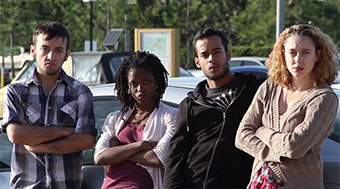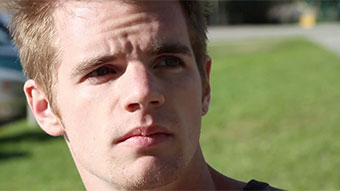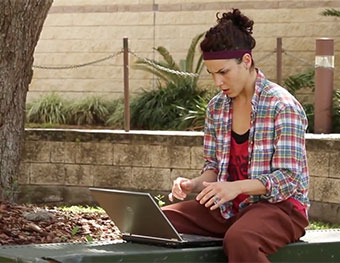Features
Beyond Words
| USF News
Barely two months after joining the USF dance faculty in 2010, Andrew Carroll was approached by the Florida Department of Health with an interesting opportunity: produce a pop-culture dance video to illustrate how to properly clean a hospital room, particularly high-touch surfaces.
A soloist with the Pennsylvania Ballet Company for nine years, and a principal with the Ohio Ballet prior to that, Carroll was keenly aware of the power of dance to communicate an idea. But, could the medium effectively communicate very specific educational concepts — such as never leave a hospital room after cleaning with your cleaning gown on — without the benefit of words?
“It sounded like an innovative idea that could open the door for alternative education methods and contribute to the field of dance,” he says. “It was very interesting to me as a research agenda, and it tied in with USF’s values of collaborative and interdisciplinary work.”

Four months later, in April 2011, the upbeat, wordless video, featuring USF dance students and a score by the USF School of Music, was released. The first-of-its kind production, used at hospitals nationally and internationally today, led to a second commission for nursing homes in 2011, and a third for in-line nursing initiatives in 2012.
The video proved particularly effective with staff who didn’t have English as their primary language.
And that got Carroll thinking. Maybe this popular medium could be used to tackle the social issue of bullying.
“It’s a relevant and important topic, and one that is very much a part of the dance world,” he says.
With a lead male dancer in mind who would graduate in a matter of months, Carroll had to work quickly. He applied for a small grant from the USF College of The Arts and began contacting experts to ensure the production would address the latest research and findings on bullying.
For the video that meant:
- It wasn’t enough to include a male who was being bullied; the video should include a female bullying victim as well.
- The video had to communicate that anyone can be a bully; bullies don’t come from any single group.
- The issue of cyberbullying had to be addressed. Advances in technology mean home is no longer a safe haven for victims of bullying.
- There had to be a call to action — if you witness someone being bullied, do something.
For four months, beginning in January 2012, Carroll and his USF team, including School of Theatre and Dance students Tyler Orcutt, Nicole Diaz, Jenne-Elise Galluzzi, Sean McDonald, Julien Valme and Brittany Williams, along with videographer Stephen John Ellis and lighting specialist Beau Edwardson, worked on the project. International cellist Zoe Keating, and vibraphonist Michael Ortega, agreed to have their music featured in the production after reviewing sample footage.

By April, it was a wrap — just weeks before Orcutt, the bullied male featured in the video, was set to graduate.
“It was really awesome,” says Orcutt, now a dancer with the Repertory Dance Theatre in Salt Lake City, Utah. “I haven’t been bullied so I had to learn to understand what someone who is bullied is going through and would feel on the inside. I did research; I read blogs.”
The experience, he adds, opened his eyes to the issue of bullying.
Set against a school backdrop, the nearly 7-minute dance video tells the story of two students, a male and a female, being relentlessly taunted and teased in person and online by a group of students. The taunts, expressed in varying forms of dance and set to often-pulsating music, bring the targets to their knees. Solo performances by lead dancers Orcutt and Diaz open the bullies’ eyes to the pain they have caused. Over time the students — the bullies, the bullied and uninvolved bystanders — unite to put an end to the violence.
Diaz, now a senior at USF majoring in modern dance, says the production carries important messages for several distinct audiences — people who bully and know it; people who bully, or condone bullying behavior, and don’t know it; people who are bullied; and people who have nothing to do with bullying, but stumble upon it.
Even herself.
“When I first started, the idea of bullying seemed so archaic. But the more I got involved, it became reminiscent of moments I had as a child,” she says. “And it got me thinking about moments I may have condoned that behavior or made someone feel inferior in any way, even if it wasn’t an intentional action on my part.”

She says working on the video gave her new and invaluable experience, and an important addition to her resume.
“It gave me the chance to collaborate with a filmmaker; to get out of the studio and off of the stage. It made me access my acting skills. It was a liberating experience.”
After a first showing at a USF symposium, one viewer, a self-proclaimed bully in high school, thanked Carroll for the effort. “The young man said he was a bully in high school and not a day goes by that he doesn’t regret the horrific things he did,” Carroll recounts. “He said had there been a video like this around, he probably would have stopped.”
In just six months, the video reached a national and international audience as a lead-in for bullying programs and teen advocacy agencies, including Teen Advocacy Group (TAG) in Atlanta and Foundations in Denver, as well as several anti-bullying organizations, the Stand for the Silent national website, and the Greater Los Angeles public school system. It has been seen by students in Australia, Northern Ireland, Finland and Scotland.
A letter from Pacer’s National Bullying Prevention Center in Minnesota lauded the production:
“As one of the leading bullying prevention organizations in the world, we receive a steady stream of creative submissions. I must tell you, your dance video is one of the most amazing contributions we have seen! With your permission, we would like to use it on our primary website. In addition, we would like to explore the possibility of using it in our school curriculum as part of a bullying prevention toolkit.”

Andrew Carroll, who holds a B.F.A. in Dance, and an M.A. in Arts Administration, was a professional soloist and director before joining USF.
Photo courtesy of Andrew Carroll.
Carroll, who has performed at venues around the world, and was named a cultural ambassador for the City of Philadelphia, calls the letter “one of my proudest moments.”
“I am not a psychologist or psychiatrist; I am a choreographer,” he says. “I have come up with something that has truth and validity. There are so many topics — substance abuse, domestic violence, body image — that could be depicted through this medium that teens like so well.”
And despite the outpouring of requests from schools and organizations to use the video as part of an anti-bullying effort, Carroll is adamant it wouldn’t be appropriate to charge a licensing fee. If it stops just one, he says, that would be payment enough.
The experience has changed his focus.
“I started on this path and it has become my path,” he says. “To give back to my field and to make a contribution to help stop bullying, that is really satisfying.”